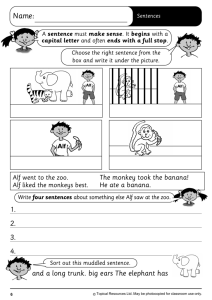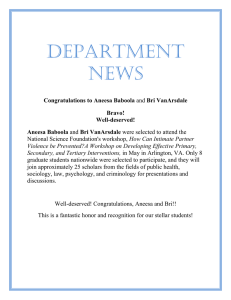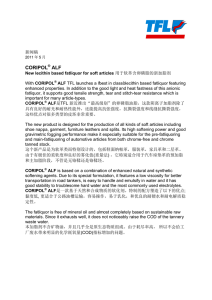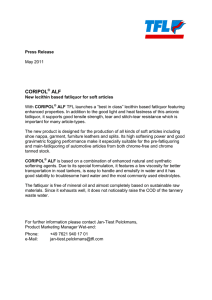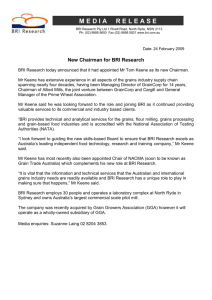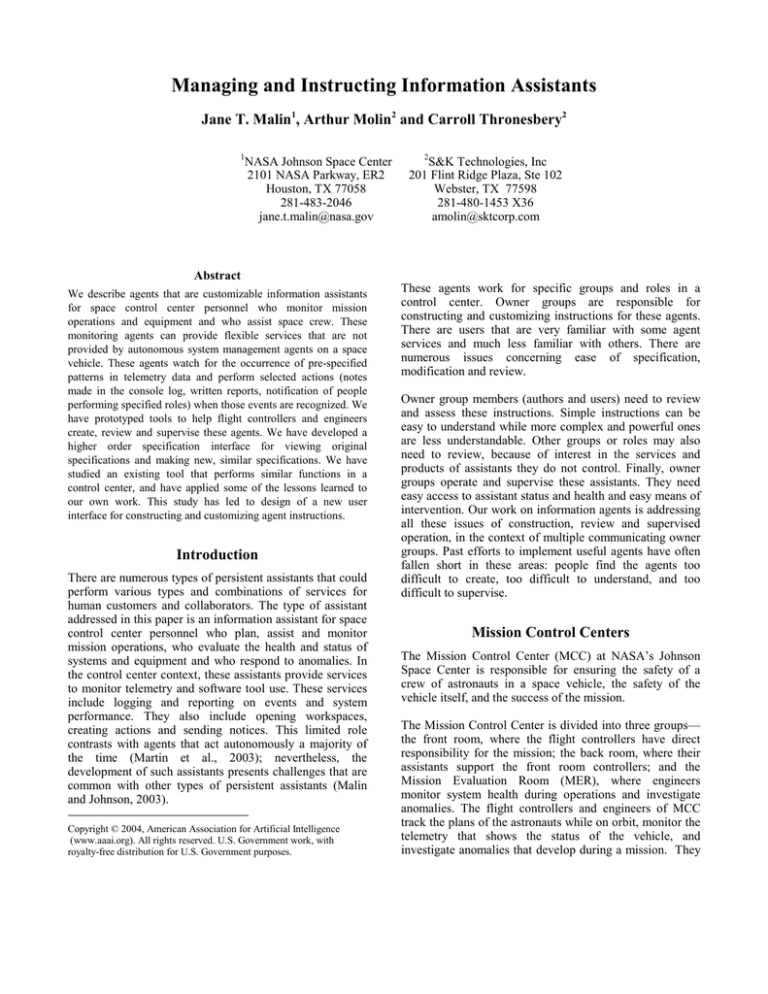
Managing and Instructing Information Assistants
Jane T. Malin1, Arthur Molin2 and Carroll Thronesbery2
1
NASA Johnson Space Center
2101 NASA Parkway, ER2
Houston, TX 77058
281-483-2046
jane.t.malin@nasa.gov
2
S&K Technologies, Inc
201 Flint Ridge Plaza, Ste 102
Webster, TX 77598
281-480-1453 X36
amolin@sktcorp.com
Abstract
We describe agents that are customizable information assistants
for space control center personnel who monitor mission
operations and equipment and who assist space crew. These
monitoring agents can provide flexible services that are not
provided by autonomous system management agents on a space
vehicle. These agents watch for the occurrence of pre-specified
patterns in telemetry data and perform selected actions (notes
made in the console log, written reports, notification of people
performing specified roles) when those events are recognized. We
have prototyped tools to help flight controllers and engineers
create, review and supervise these agents. We have developed a
higher order specification interface for viewing original
specifications and making new, similar specifications. We have
studied an existing tool that performs similar functions in a
control center, and have applied some of the lessons learned to
our own work. This study has led to design of a new user
interface for constructing and customizing agent instructions.
Introduction
There are numerous types of persistent assistants that could
perform various types and combinations of services for
human customers and collaborators. The type of assistant
addressed in this paper is an information assistant for space
control center personnel who plan, assist and monitor
mission operations, who evaluate the health and status of
systems and equipment and who respond to anomalies. In
the control center context, these assistants provide services
to monitor telemetry and software tool use. These services
include logging and reporting on events and system
performance. They also include opening workspaces,
creating actions and sending notices. This limited role
contrasts with agents that act autonomously a majority of
the time (Martin et al., 2003); nevertheless, the
development of such assistants presents challenges that are
common with other types of persistent assistants (Malin
and Johnson, 2003).
Copyright © 2004, American Association for Artificial Intelligence
(www.aaai.org). All rights reserved. U.S. Government work, with
royalty-free distribution for U.S. Government purposes.
These agents work for specific groups and roles in a
control center. Owner groups are responsible for
constructing and customizing instructions for these agents.
There are users that are very familiar with some agent
services and much less familiar with others. There are
numerous issues concerning ease of specification,
modification and review.
Owner group members (authors and users) need to review
and assess these instructions. Simple instructions can be
easy to understand while more complex and powerful ones
are less understandable. Other groups or roles may also
need to review, because of interest in the services and
products of assistants they do not control. Finally, owner
groups operate and supervise these assistants. They need
easy access to assistant status and health and easy means of
intervention. Our work on information agents is addressing
all these issues of construction, review and supervised
operation, in the context of multiple communicating owner
groups. Past efforts to implement useful agents have often
fallen short in these areas: people find the agents too
difficult to create, too difficult to understand, and too
difficult to supervise.
Mission Control Centers
The Mission Control Center (MCC) at NASA’s Johnson
Space Center is responsible for ensuring the safety of a
crew of astronauts in a space vehicle, the safety of the
vehicle itself, and the success of the mission.
The Mission Control Center is divided into three groups—
the front room, where the flight controllers have direct
responsibility for the mission; the back room, where their
assistants support the front room controllers; and the
Mission Evaluation Room (MER), where engineers
monitor system health during operations and investigate
anomalies. The flight controllers and engineers of MCC
track the plans of the astronauts while on orbit, monitor the
telemetry that shows the status of the vehicle, and
investigate anomalies that develop during a mission. They
record events, conversations, analyses and things to do in
the console logs.
agents and the people will use the same collaboration
software to update and track events and issues.
Flight controllers and engineers within MCC and MER are
divided into groups called disciplines, each with a specific
responsibility—Life Support, Power, Medical, and so on.
Currently, one or a few individuals who are on shift at any
given time represent each discipline within MCC. The
flight controllers are a large and changing group of people;
new flight controllers are constantly going through a
rigorous training process, in order to be ready to replace
those who leave.
We envision that each discipline will develop its own set of
instructions for software agents to help within its area of
expertise. These agents will be interdependent, in the same
way that the disciplines are interdependent. For example, if
the Life Support discipline foresees a problem with oxygen
generation, they will inform the Medical discipline. The
software agents can communicate with each other and with
the flight controllers and engineers. New software agents
will be created to monitor specific, short-term issues; when
the issue is resolved, that agent could be eliminated,
without touching any of the other agents in the
environment.
Currently, flight controllers spend a significant amount of
time monitoring telemetry data. Some software is available
for monitoring data and logging anomalies, but it has not
been widely adopted. One such tool, the Automated
Logging Function, or ALF, is currently used by the MER
engineers who monitor the Space Shuttle Remote
Manipulator System (RMS). ALF users can specify rules
involving telemetry values, to trigger creation of log
messages when the rule is matched. Rules can match when
a telemetry value exceeds a threshold, or takes a discrete
value. This tool has been used by one engineering
discipline, but it has not been broadly accepted.
The Space Shuttle MCC at Johnson Space Center is fully
staffed at all times during a mission, but that is impractical
for the International Space Station MCC (JSC-29229,
2003). Because of the continuous mission, MCC is not
fully staffed during the night shift. The current night and
weekend staffing is handled by Gemini flight controllers.
Each Gemini flight controller has expertise in a few
disciplines. In the first version of this program, Station
Duty Officers from the Communications discipline manned
the night shift, and followed a set of instructions from each
discipline. These Anomaly Response Instructions specified
out-of-bounds telemetry values, and the actions that should
be taken if the values were observed. The instructions
called for things like logging telemetry values, waiting until
a value had exceeded the threshold for a certain period of
time, and notifying or calling in flight controllers in the
correct discipline. These Anomaly Response Instructions
were the artifacts and inspiration for Briefing and Response
Instructions (BRIs) for the information assistants.
Our Vision for the Future
Our team has proposed a future view of the Mission
Control Center, where tools are available via the World
Wide Web, in the MCC itself, in the other offices at
Johnson Space Center, and potentially in contractor offices
and partners’ locations around the world. Software agents
will take over the tasks of monitoring data and logging
events. When an anomaly occurs, the software agents will
notify members of anomaly response teams and support
them (Malin, 2004). When the team is called in, they will
find the data that they need already available. The software
These agents will communicate with the flight controllers
using the same software that the flight controllers use to
communicate with each other. Flight controllers will be
able to easily review the actions of the software agents, and
determine what they are doing and why.
This vision takes concrete form with the Briefing and
Response Instruction (BRI) System, which consists of the
BRI Editor, an easy-to-use, general-purpose editor for
developing BRIs, and the BRI Engine, an engine that can
process data sources and apply BRIs to them. The term
BRI was developed as an analogy to the Anomaly
Response Instruction.
Using the BRI Editor, a person can develop the BRIs,
which are instructions to be performed when a particular
pattern is observed in input data. When the BRI Engine is
loaded with a set of BRIs, and connected to a set of data
inputs, we call the result an instance of an Intelligent
Briefing and Response Assistant, or IBRA. These IBRAs
are envisioned as supporting ground operations. They will
perform many of the simpler tasks currently performed by
the flight controllers in the front and back rooms. They
will monitor the telemetry stream from the vehicle,
detecting anomalous conditions. When the conditions are
detected, the IBRA can log the event, send a message to the
discipline responsible for the system, or create an anomaly
workspace with status information and references about the
condition, to support the engineers and anomaly response
team.
Our team has been designing, developing and evaluating a
suite of web-based tools as a prototype of the collaborative
environment we have envisioned. Extensive human
centered analysis has guided the design and development of
the tool suite (Malin et al., 2002; Rinkus et al., 2005;
Rukab et al., 2004; Zhang et al., 2004). This tool suite,
called Team Work Center, has the following teamwork
support features:
Team members and IBRAs use the same tools, to facilitate
incremental agent development and learning approaches
that reuse techniques of users.
Web-based and database-based tools facilitate global and
tool-independent access and search.
Explicit content links between tools enable finding things
and keeping track of their locations, minimizing extra
data entry effort or errors.
The Team Work Center consists of
• Databased Logger - to create a database of log entries
that supports review of large log files, automated
logging, and generation of reports and specialized logs
• WorkIT Workspace Manager - to collect and share
items related to an issue or anomaly or work topic in
one accessible workspace, with capability to handle
files, links, actions, logs, and paperwork
• Report Maker - to create report formats and collect
information from multiple sources (log entries, data,
data analyses, notices, actions, procedures, links to
workspaces and references) into formatted reports such
as shift handover reports and reports about anomalies.
• Notifier - to manage notification of team members on
or off console
• Team Work Center Viewport - to provide a summary
view and access to recent products of the other tools.
Intelligent Briefing and Response Assistants (IBRAs) use
these tools to manage information, and to increase team
understanding of events, assessments, priorities, and plans.
IBRA actions can be triggered by data from the tools and
from from intelligent system management agents (ISMAs)
on a space vehicle or base. ISMAs manage spacecraft
systems and handle anomalies. IBRA actions include
making console Logger entries and assembling reports and
briefings in issue workspaces. IBRAs can pass on
information from ISMAs concerning goals, procedures,
control regimes, configurations, states and status.
IBRAs display their current status in the Team Work
Center Viewport so that flight controllers can track the
agents associated with their own and other disciplines. It is
a way for the people to be aware of what software agents
are running, what they are doing, and why.
Design for Use
In designing IBRAs and tools for developing Briefing and
Response Instructions (BRIs) we have identified several
human-centered considerations. These include ease of
construction, ease of review, and ease of supervision.
agents that perform related jobs, extracting the knowledge
from them, modifying it and inserting it into the new agent.
Once the agent is created it must be reviewed. Other people
than the original creator must be able to understand the
agent; the agent might well outlive the tenure of the
original creator. The agent must be debugged and verified,
possibly by someone other than the creator. As situations
change, the agent must be modified. Flight controllers and
engineers will also review agents from other disciplines, to
ensure that their concerns are being met, and to subscribe
to receive products of the agents.
Finally, the agents must be supervised while they are
operating. In order for software agents to work as teammembers with people, the people must be able to oversee
what the agents are doing. People will always have a need
to determine
• What the agent is doing
• Why it is doing that
• What it is going to do next
ALF: Problems of Construction and Review
To aid our design work, we have studied the Automated
Logging Function (ALF) tool and reviewed the rules that
are routinely used. ALF has been used by the Mission
Evaluation Room engineers who monitor the Space Shuttle
RMS, but to date not by any other groups. We were
interested in the kind of rules that engineers would want
when using a tool of this nature. In addition, we were
interested in why the ALF tool, which has been in use for at
least 10 years, has not been more widely accepted.
We determined that one of the limits to wide usage of the
tool is the lack of tools to specify and review rules. The
rules are specified in a C-like programming language. The
target users, while computer savvy, are not computer
programmers. A simple rule in the ALF language is shown
in Figure 1. Even our programmer evaluators of ALF had
to ask for expert help to understand ALF rules.
if (changed(#V72X2931J))
if (#V72X2931J <
ABE_TEMP_ACC_HI_LIMIT + 1.0)
logmesg(STATUS_CAUTION,
"ABE_TEMP_QUAL_HI_LIMIT is below
ABE_TEMP_ACC_HI_LIMIT + 1.0");
Figure 1 Sample ALF Code
One of the central goals of our project is to allow domain
experts to develop intelligent assistants to help them do
their jobs. This is the task of constructing the agent. It
involves specifying the conditions under which the agent
must act, and what it must do under those conditions. The
domain expert must be able to enter this knowledge and
annotate it. Often, this will involve looking at existing
We reviewed the ALF rules that were in use, and
determined that almost all of them fell into one of a few
general patterns. We identified three basic types that
covered more than 90% of the existing ALF rules:
Event Definition: This type defines an event that occurs
when a telemetry value or internal variable is set to a value
above, below, or equal to a threshold level. In response to
the event, the system will either set an internal variable, or
generate a log message.
Limit Specification: The range of legal values for a
telemetry or variable are divided into high, nominal, low.
The high and low sections can be further divided into
caution and warning ranges. A "deadband" can be defined
around any of the transitions, which prevents bogus
messages when a telemetry is hovering right around a
threshold value. When the telemetry or variable crosses a
threshold, the appropriate log message is generated.
Timing Definition: This defines an event that is made up of
a start event and an end event, with a duration associated
with the compound event. Both start and end events will
individually match Event Definitions, and the same
interface would be reused to define them. When both
events have occurred, a log message will be generated with
the time taken between the
events.
available in the telemetry database and can be displayed in
a list. Other telemetry fields are numeric, in which case
arithmetic operations can be applied to the field.
The next sub-window of the interface allows the user to see
the log message that would be printed for the given rule.
We observed that the log messages printed out by the
existing ALF rules usually follow a strict format, describing
the event that triggered the message, and we implemented
that format as the default message. The user can override
the default with a specific message if desired.
In the final sub-window, the user can create or set a
variable. These local variables can be used in the other
rules.
We are developing capabilities to allow new rule templates
to be developed by more sophisticated users; these new
rule templates would then be available to be used by nonprogrammers, to create rules that instantiate them.
We developed designs for
template interfaces for domain
experts, to help them easily
specify these types.
We
developed prototypes of the
interfaces, and are preparing to
have ALF users evaluate the
prototypes. One of these
prototypes is shown in Figure
2.
A user who opens this
interface will see three subwindows. The top window is
used to define the conditions
under which the rule will
become active. The first
decision made is to choose the
telemetry field or internal
variable the rule is referring to.
An interface into a missionspecific database allows the
user to search for the defined
telemetry values, and a
scrolling list gives all of the
variables that have been
defined by other rules. Next,
Figure 2 Prototype of a Rule Template
the user will choose the
comparison that will be
applied to the value. Finally,
the condition can be specified. This is an expression
involving telemetry field, variables, and constants. Some
telemetry fields take discrete values; these values are
IBRA Construction, Review and Supervision
Construction
Prior to the ALF study, we had developed a general
purpose, graphical editor for creating BRIs. The editor has
a drag-and-drop style interface, allowing users to choose
from a palette of objects, drop them into a graphical
window, and connect them together. The editor can be seen
in Figure 3, showing a window for defining the conditions
under which the rule will become active. The BRI Editor
shows the rule triggers and the actions in separate windows.
Figure 3 The BRI Editor
This editor has been evaluated twice, first by members of
the development team. This evaluation led to a number of
changes that were implemented in 2004. The outside
evaluator who studied the ALF rules also re-implemented
these rules using the BRI Editor. One of the resulting
recommendations led to the design of a template interface.
Others have not yet led to design changes.
We intend to develop the template editors in such a way
that they can generate either ALF or BRI rules. This will
give us an alternate editing platform to evaluate. In use, if a
user needed to create a “standard” BRI, one that matched
an existing template, the template editor could be used. If
the BRI did not match any existing template, then the BRI
Editor could be used directly.
The BRI System is built around XML data. We have found
that the flight controllers have a good understanding of the
data produced by the systems they monitor. One of the
goals of the design is to have the representation of the
pattern that describes data to be as close as possible to the
representation of the data itself. As XML is inherently treestructured, the patterns match that structure.
When building a BRI, it is necessary to be able to explore
the data that the BRI is intending to match. The BRI Editor
has a number of specific features to support that. Users can
load a file of sample data, or load a DTD file that specifies
the possible contents of the data file.
If a sample data file is loaded, it is simple to select a
portion of the XML tree in the
sample data window, and drop
it into the pattern window.
This creates a pattern that will
match exactly that sample
subtree, but it is easy to then
modify the pattern until it
meets the needs. If a DTD is
loaded, then the patterns can
be build in a “top-down”
fashion. At each level, a
drop-down list shows the data
items that might be found as
children of the selected data
items. Alternatively, the user
can type in the data that is
expected, even if that does not
match the DTD.
We find that most users prefer
to find an existing example
that is “close” to the problem
that they have in mind, and
then modify it for their exact
situation. The BRI Editor
makes it easy to review the
existing BRIs and quickly
determine their purpose and function. The BRI Editor also
has a number of features to make it easy to cut, paste, and
modify existing BRIs once found.
Review
There are two general purposes for reviewing a rule. The
first is to understand the details about why a rule has fired.
The regular output from the rule firing (new information
written to the console log, notices sent out to specified
individuals, written reports generated) is intended to
contain sufficient information to take initial action.
However, additional information is sometimes required for
detailed analysis of an anomaly in the monitored system
underlying an event recognized by the IBRA agent. In this
case, the user can request a view of the rule to see a
detailed description of the characteristics required for the
rule to fire. Any details the user may have forgotten since
the initial specification of the rule can be reviewed so that a
full analysis of the underlying event can be performed.
The second purpose of reviewing a rule is to enable the
user to refine the rule specification to reflect new
knowledge the user has gained from continued experience
with the monitored system. We feel this is a critical aspect
of persistent assistant agents: to allow their behavior to be
refined as human users gain experience (and knowledge).
The refinement can be in terms of either the recognition
characteristics or the actions to be taken when the event is
recognized. The user interface is essentially the same as
for the initial rule specification.
plan to allow users to control the IBRAs via this
interface—to load, unload, activate and deactivate BRIs, to
call for reports on recent activities, and to start and stop the
IBRAs.
The BRI Editor supports review by allowing the user to
load sample data sets and see which of the BRIs are
activated by which elements of the data set. This provides a
simple testing and debugging environment, as well as a way
to review the actions of the BRIs with real data.
The ALF-based templates provide explicit feedback and
review of both trigger and action by showing the log
message that would be printed. That message typically
includes the trigger and implicitly includes the action
(logging) for an event rule.
Supervision
To develop visibility into IBRA status we have developed a
Status Monitor for human and artificial agents that is
available through the Team Work Center Viewport. The
Team Work Center Viewport will allow flight controllers
to monitor the IBRAs associated with their discipline, to
ensure that everything is operating nominally. This
interface will allow them to monitor the health of the
IBRAs, load and unload specific BRIs for specific
situations, and query the IBRAs for expected events.
Since IBRAs are expected to come and go as they are
needed, the Team Work Center Viewport is a dynamic
view, ensuring that it is up-to-date. Some IBRAs can be
marked as “expected” in the configuration files, and if they
are absent then their absence can be flagged; others will be
transitory, and when they shut themselves down no error
message would be displayed.
From the list of all agents present in the environment, the
user can choose one, and “push down” to see a more
detailed view of its status. This would show the BRIs that
are loaded, enabled and disabled, what data sources are
connected and which have not produced data lately.
The interface can be seen in Figure 4. This interface is still
under development. We need to determine how to present
this information to our users in a fashion they can easily
understand, and, ultimately, how we can answer the
questions that they have about the IBRA agents. We also
Figure 4 The BRI Monitor
Technical Description of IBRAs
The IBRA system is based on CLIPS, a rule-based
programming language developed as an expert system shell
at Johnson Space Center. This useful and powerful
language is under-utilized, partly because the syntax of the
language is unfamiliar and the programming style foreign
to most programmers. We wanted to develop a tool that
would make the development CLIPS programs easier.
At the same time, we observed that XML was becoming
commonly used as a data interchange program. We
decided to develop a way to easily process XML data in a
rule-based language such as CLIPS. It was important to be
able to process arbitrary XML schemas, in order to work
with tools that we did not control.
The Team Work Center, Database Logger, and
ReportMaker prototypes use ColdFusion and a mySQL
database. The WorkIT workspace tool prototype uses
ColdFusion and an Oracle database.
implemented the Team Work Center Agent Visibility
window, and to Kevin Kusy, who implemented much of the
BRI Editor and BRI Engine.
References
Conclusions and Future Work
In the course of this project, we have confirmed that if
intelligent software is too difficult to understand, it will not
be widely used. The problem of developing intelligent
software does not really end with construction and
execution. People will have to live with the software for
extended periods of time. If they don’t understand it, if it
does not fit into their world view, if they don’t understand
what it is doing and why—they will not rely on it or use it.
We have also found that flexibility and configurability are
critical. Different user communities have different needs.
They must be able to adapt the software to their own
processes.
The entire environment has been successfully demonstrated
in the past two years. The Team Work Center, WorkIT
and Logger tools have been used in simulations in the
Mission Control Center, as well as in mission control for
NASA Extreme Environment Mission Operations
(NEEMO) undersea missions. We are preparing for an
evaluation of the BRI System in the Medical discipline of
the International Space Station.
We have gone through two design iterations with the BRI
Editor, and have incorporated good ideas from several
evaluators. Our current focus of attention is the problem of
supervision; how the software can be monitored; how it can
report its state in a way that can be understood; and what
information a user needs about the current status of an
intelligent agent.
The largest challenge currently facing NASA is the new
charter to return to the Moon and to Mars. This challenge
will require a re-evaluation of many of the existing ways of
“doing business,” and we hope to have our ideas
represented. The next-generation manned space vehicles
will likely be more autonomous from the ground than are
the Space Shuttle and International Space Station, and a
manned mission to Mars will have to be more autonomous.
This might well be achieved by having many of the
functions of the Mission Control Center performed on the
vehicle itself, by intelligent software agents much like the
IBRAs.
Acknowledgements
Thanks to Nina Patel, who studied the ALF rules and
evaluated the BRI Editor. Thanks to Harold (Sonny)
White, who helped us understand ALF and the RMS
monitoring rules. Thanks also to Patrick Oliver, who
Malin, J. T.; Johnson, K.; Molin, A.; Thronesbery, C.; &
Schreckenghost, D. Mar, 2002. Integrated Tools for
Mission Operations Teams and Software Agents, 2002
IEEE Aerospace Conference. Washington, D.C.: IEEE.
Malin, Jane T. 2004 Interaction between Autonomous
Systems and Anomaly Response Teams. In Interaction
between Humans and Autonomous Systems over Extended
Operations: Papers from the AAAI Spring Symposium.
AAAI Press, Technical Report, SS-04-03, Stanford, CA,
March, 2004 (pp. 133-135).
Malin, J. T. & K. Johnson, 2003. Information for
Successful Interaction with Autonomous Systems. In
Human Interaction with Autonomous Systems in Complex
Environments: Papers from the 2003 AAAI Spring
Symposium, AAAI Press, Technical Report SS-03-04 (pp.
129-133).
Martin, C.; D. Schreckenghost; P. Bonasso; D.
Kortenkamp; T. Milam; & C. Thronesbery. March, 2003.
Aiding Collaboration among Humans and Complex
Software Agents. AAAI Spring Symposium. Workshop on
Human Interaction with Autonomous Systems in Complex
Environments. AAAI Spring Symposium
Rinkus, S.; Walji, M.; Johnson, K. A.; Malin, J.; Smith, J.
W.; Turley J. P.; Zhang, J. 2005, in press. Distributed
cognition in knowledge management design. Journal of
Biomedical Informatics.
Rukab, J. A., Johnson-Throop, K. A., Malin, J., & Zhang,
J. 2004. A Framework of Interruptions in Distributed Team
Environments. In M. Fieschi, E. Coiera, & Y. C. J. Li
(Eds.), Proceedings of 11th World Congress on Medical
Informatics (pp. 1282-1286). Amsterdam: IOS Press.
Thronesbery, Carroll; Jane T. Malin; Ken Jenks; David
Overland; Patrick Oliver; Jiajie Zhang; Yang Gong; & Tao
Zhang. 2005, in press. A Data-Based Console Logger for
Future Mission Operations Team Coordination.
Proceedings of IEEE Aerospace Conference 2005.
Washington, D.C.: IEEE.
International Space Station Flight Controller Operations
Handbook (FCOH) (JSC-29229, rev DCN0006). October,
2003. Houston: Johnson Space Center.
Zhang, T., Aranzamendez, D., Rinkus, S. M., Gong, Y.,
Rukab, J., Johnson-Throop, K. A., Malin, J., Zhang, J.
(2004). An Information Flow Analysis of a Distributed
Information System for Space Medical Support. In M.
Fieschi, E. Coiera, & Y. C. J. Li (Eds.), Proceedings of 11th
World Congress on Medical Informatics (pp. 992-996).
Amsterdam: IOS Press.

